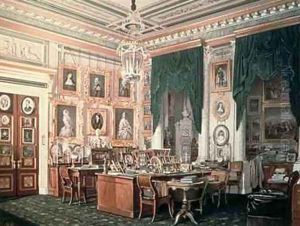Eduard Hau Paintings
Eduard Hau, born Johann Eduard Hau, was a notable Baltic German painter, particularly recognized for his work as a portraitist and as a master of interior scenes. Born on January 26, 1807, in Mitau (now Jelgava, Latvia), which was then part of the Duchy of Courland and Semigallia (a client state of the Russian Empire), Hau showed an early interest and talent in the arts.
His initial artistic training began under the guidance of Karl Hübner at the Imperial Academy of Arts in Saint Petersburg, where he honed his skills and developed a keen eye for detail. Hau's aptitude was evident, and he quickly rose to prominence within the Russian artistic circles. He became particularly well-regarded for his finely detailed interior scenes, which often captured the opulence and grandeur of palatial settings.
In the 1830s, Hau traveled to Europe, spending time in Italy and Germany, where he was influenced by the works of other European artists. This exposure to different styles and techniques further enriched his own painting style. Upon his return to the Russian Empire, he settled in Saint Petersburg and became a member of the Academy of Arts. He was appointed as a court painter, which allowed him to gain access to the lavish interiors of the Russian palaces and the nobility, becoming a sought-after artist for his realistic portrayals and intricate attention to fabrics and materials.
Hau's reputation was not limited to Russia, as his works were also appreciated abroad. His ability to capture the likeness and character of his sitters, as well as the luxurious surroundings of the Russian elite, made his portraits highly desirable. Throughout his career, Hau continued to exhibit his works and received numerous accolades for his contributions to the art world.
Eduard Hau passed away on December 5, 1888, in Saint Petersburg. Although he may not be as widely known today as some of his contemporaries, his works remain a valuable record of the 19th-century Russian aristocracy and their living environments, offering a window into a bygone era. Hau's paintings can be found in various museum collections, including the Hermitage Museum in Saint Petersburg, testifying to his enduring legacy in the history of art.








